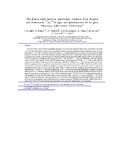| dc.contributor.author | Jourdan, F. | |
| dc.contributor.author | Fe´raud, G. | |
| dc.contributor.author | Bertrand, H. | |
| dc.contributor.author | Kampunzu, A.B. | |
| dc.contributor.author | Tshoso, G. | |
| dc.contributor.author | Le Gall, B. | |
| dc.contributor.author | Tiercelin, J.-J. | |
| dc.contributor.author | Capiez, P. | |
| dc.date.accessioned | 2009-10-06T13:38:27Z | |
| dc.date.available | 2009-10-06T13:38:27Z | |
| dc.date.issued | 2004 | |
| dc.identifier.citation | Jourdan, F. et al (2004) The Karoo triple junction questioned: evidence from Jurassic and Proterozoic 40Ar/39Ar ages and geochemistry of the giant Okavango dyke swarm (Botswana), Earth and Planetary Science Letters, Vol. 222, pp. 989–1006 | en_US |
| dc.identifier.issn | 0012-821X | |
| dc.identifier.uri | http://hdl.handle.net/10311/383 | |
| dc.description.abstract | The lower Jurassic Karoo–Ferrar magmatism represents one of the most important Phanerozoic continental flood basalt
(CFB) provinces. The Karoo CFB province is dominated by tholeiitic traps and apparently radiating giant dyke swarms covering
altogether ca. 3 106 km2. This study focuses on the giant N110j-trending Okavango dyke swarm (ODS) stretching over 1500
km across Botswana. This dyke swarm represents the main (failed) arm of the so-called Karoo triple junction that is generally
considered as a key marker of the impingement of the Karoo starting mantle plume head. ODS dolerites yield six new plagioclase
40Ar/39Ar plateau (and miniplateau) ages ranging from 178.7F0.7 and 180.9F1.3 Ma. The distribution of the ages along a
narrow Gaussian curve suggests a short period of magmatic activity centered around 179 Ma, i.e., f5 Ma younger than the
emplacement age of Karoo mafic magmas in the southern part of the Karoo CFB province (f184). This age difference indicates
that Karoo magmatism does not represent a short-lived event as is generally the case for most CFB but lasted at least 5Ma over the
whole province. In addition, small clusters of plagioclase separated from 28 other dykes and measured by ‘‘speedy’’ step-heating
experiments (with mostly two to three steps), gave either ‘‘Karoo’’ or Proterozoic ages. Integrated ages of the Proterozoic rocks
range from 851F6 to 1672F7 Ma, and one plateau age (959.1F4.6 Ma) and one possibly geologically significant weightedmean
age (982.7F4.0 Ma) were obtained. Proterozoic and Karoo mafic rocks are petrographically similar, but Proterozoic dykes
display clear geochemical differences (e.g., TiO2 < 2.1%) with the Karoo high-Ti ODS (TiO2>2.1%). Geochemical data combined
with available Ar/Ar dates allow the identification of the two groups within a total set of 77 dykes investigated: f10% of the
bulk ODS dykes are Proterozoic. Thus, the Jurassic Karoo ODS dykes were emplaced along reactivated Proterozoic structures
and there is no pristine Jurassic Nuanetsi triple junction as commonly proposed. This throws into doubt the validity of the ‘‘active
plume head’’ Karoo CFB rift models as being responsible for the observed ‘‘triple junction’’ dyke geometry | en_US |
| dc.language.iso | en | en_US |
| dc.publisher | Elservier www.elsevier.com/locate/epsl | en_US |
| dc.subject | 40Ar/39Ar dating | en_US |
| dc.subject | Geochemical discrimination | en_US |
| dc.subject | Dyke swarm | en_US |
| dc.subject | Triple junction | en_US |
| dc.subject | Karoo | en_US |
| dc.subject | Mantle plume | en_US |
| dc.title | The Karoo triple junction questioned: evidence from Jurassic and Proterozoic 40Ar/39Ar ages and geochemistry of the giant Okavango dyke swarm (Botswana) | en_US |
| dc.type | Published Article | en_US |

